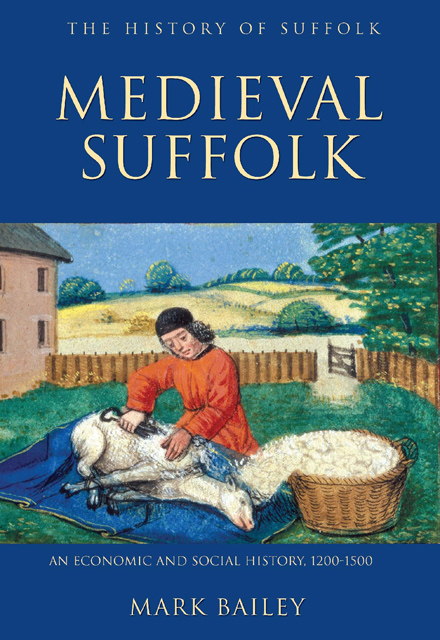Book contents
- Frontmatter
- Contents
- List of Plates
- List of Maps
- List of Tables
- Foreword
- Acknowledgements
- Note on Currency & Units of Measurement
- Abbreviations
- 1 Introduction
- 2 Landlords and their Estates, 1200–1349
- 3 Peasants and their Lifestyles, 1200–1349
- 4 The Agrarian Economy, 1200–1349
- 5 The Suffolk Landscape, 1200–1349
- 6 Towns and the Urban Environment
- 7 Commerce, Crafts and Industry
- 8 Pestilence, Rebellion and the Decline of Villeinage, 1349–1500
- 9 The Rural Economy, 1350–1500
- 10 ‘The World Turned Upside Down’: Rural Society, 1350–1500
- 11 Towns, Trade and Industry, 1350–1500
- 12 Conclusion
- Bibliography
- Index
- Frontmatter
- Contents
- List of Plates
- List of Maps
- List of Tables
- Foreword
- Acknowledgements
- Note on Currency & Units of Measurement
- Abbreviations
- 1 Introduction
- 2 Landlords and their Estates, 1200–1349
- 3 Peasants and their Lifestyles, 1200–1349
- 4 The Agrarian Economy, 1200–1349
- 5 The Suffolk Landscape, 1200–1349
- 6 Towns and the Urban Environment
- 7 Commerce, Crafts and Industry
- 8 Pestilence, Rebellion and the Decline of Villeinage, 1349–1500
- 9 The Rural Economy, 1350–1500
- 10 ‘The World Turned Upside Down’: Rural Society, 1350–1500
- 11 Towns, Trade and Industry, 1350–1500
- 12 Conclusion
- Bibliography
- Index
Summary
To the casual observer or the incurious visitor the county of Suffolk might appear to be a pleasant, but undistinguished, backwater. Its landscape is not dramatic, and may be easily dismissed as flat and monotonous, while leading towns such as Ipswich, Lowestoft and Felixstowe have relatively few monuments of great historical interest. Yet the real Suffolk is a county of subtle contrasts and wide variety, and the discerning eye can identify a rich heritage of medieval religious and vernacular architecture. Many features of the modern rural and urban landscapes of Suffolk are centuries old, and were influenced significantly by developments in the Middle Ages. Modern Suffolk still reflects much of its medieval past.
In Suffolk, as elsewhere, the influence of physical geology and soil type is considerable in shaping the development of different regions and local landscapes. The county’s gently undulating countryside seldom rises higher than 200 feet (approx. 65 m) above sea-level, although one-third of west Suffolk lies above 300 feet (approx. 105 m), rising to a high point of 420 feet (140 m) near Chedburgh. Its soils are dominated by clay, which stretches in a wide crescent from Haverhill to Beccles, and also by glacial deposits of various sands, gravels and loams, which create a subtle but important diversity in both landscape and land use (map 1). This diversity was even more apparent and influential in the Middle Ages than it is today. For example, the peat fens in the north-west, and the alluvial soils around the coast, were uncultivable before widespread reclamations in the seventeenth century, and in the Middle Ages comprised extensive freshwater fens and saltwater marshlands. Similarly, the acidic sands lying to the north-west of Bury St Edmunds, and to the north-east of Ipswich, were marginal for arable farming, and harboured vast tracts of colourful and hauntingly beautiful heathland. Even the dominant clay soils are subject to variations and differences in composition – from acidic clays interspersed with glacial sands south of Ipswich, to chalky clays in the south-west, to heavy intractable clays in the north-west – which provided subtly different challenges for medieval farmers.
- Type
- Chapter
- Information
- Medieval SuffolkAn Economic and Social History, 1200-1500, pp. 1 - 9Publisher: Boydell & BrewerPrint publication year: 2007



